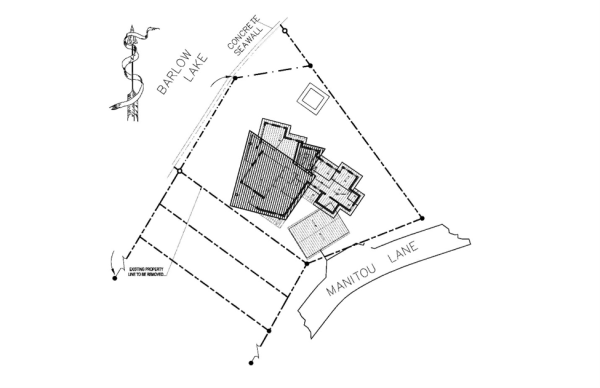How To Build A LEED Certified Home (Part 2)
Part 2 Of Designing & Building A LEED Home
This is the second installment detailing the new LEED certified house we are currently designing.
This particular LEED certified home is on a small lake in Southwest Michigan. The lake sits to the NW, so the primary views are to the NW. The lot itself is rotated 35 degrees west of due south. This LEED home wants to use good passive design features and roof mounted solar thermal and solar PV systems. The key passive LEED design feature is to rotate the main roof plan 20 degrees to the south, so that the main roof is only 15 degrees from due south facing. This passive feature helps to block the summer sun, but lets the winter sun penetrate deep into the home for passive solar heat gain and is a critical element of this specific LEED architecture. The main roof also provide a great place to put all the active systems (the PV and solar thermal). See the roof plan below. The darker roof area slope is 15 degrees from south. This passive design feature, while being a key component to the energy conservation strategy, also creates a dynamic and interesting aesthetic feature of the home.
 Further to the energy conservation considerations, LEED architecture calls for the selection of the heating and cooling systems that are currently underway. The heating load exceeds the cooling load in this region, but we need to appropriately address both needs. Heating is the main focus, but active cooling will be required in the warmest and most humid summer months. The first thing we did was to create a high performance building envelope. The wall will be Insulated Concrete Forms (ICFs), the attics will be well insulated, and we will use good quality, double glazed (insulated) windows and doors throughout, another effective element of good LEED architecture. Once the building envelope is determined, the heating and cooling systems can be properly sized. One other interesting consideration that is contributing to this effective LEED architecture is there is natural gas available at the site. And there will be many times during the year that the home will be naturally ventilated.
Further to the energy conservation considerations, LEED architecture calls for the selection of the heating and cooling systems that are currently underway. The heating load exceeds the cooling load in this region, but we need to appropriately address both needs. Heating is the main focus, but active cooling will be required in the warmest and most humid summer months. The first thing we did was to create a high performance building envelope. The wall will be Insulated Concrete Forms (ICFs), the attics will be well insulated, and we will use good quality, double glazed (insulated) windows and doors throughout, another effective element of good LEED architecture. Once the building envelope is determined, the heating and cooling systems can be properly sized. One other interesting consideration that is contributing to this effective LEED architecture is there is natural gas available at the site. And there will be many times during the year that the home will be naturally ventilated.
So we are looking at several good LEED architecture systems, keeping in mind energy efficiency, indoor environmental quality, first cost, and life cycle cost. A geo-thermal system is an option. We can get our heating and cooling from this type of system. It would be a force air distribution system - pretty standard air handlers and ducted distribution. Another option is to use a liquid base radiant flooring system. This provides and amazingly comfortable heat source. We could use solar thermal panels on the roof to supplement the mechanical heating systems (preheat the liquid on the roof and then refine the actual temperature with a gas or electric system). This can be interconnect (via a heat exchanger) with the domestic hot water system to preheat the domestic hot water system as well. With the radiant flooring system, we will need to implement a cooling system as well. This may need to be a force air distribution system, which would be a separate system from the heating system. A more conventional heat pump to provide both heating and cooling, and distributed by a force air distribution system is also an option. We will see how all these LEED architecture options play out.
We will also put solar PV panels on the roof to create as much electricity as we can afford. We will be evaluating the available roof areas for the proper balance of solar thermal and solar PV panels. Part of that analysis will be about how much (if any) natural gas we want to use, versus going with all electric systems. Stay tuned as we will be posting updates on this LEED certified home project as we make decisions and execute what we determine represents the best possible LEED architecture components.
If you are starting to research a LEED project and would like some professional advice to get you started in the right direction, feel welcome to contact us for a consultation. Just use the button below to make a request:
